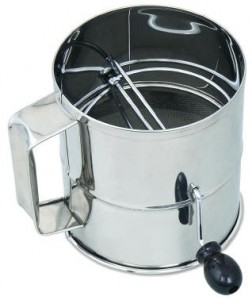The more baking recipes I run into, the more frequently I’m told to “sift” my flour. Being a novice, this mean absolutely nothing to me; typically however much flour I’m told to add I dutifully smoosh into a measuring cup and then dump into the mixing bowl. Nuh. Done.
But more recently as I seek a better working knowledge of how cakes and baking in general works, I figure it’s time to see if “this sifting thing” actually has some sort of affect on my baking.
What is Sifting?
Sifting flour means to run your flour (or other powdery substance, like cocoa powder) through a sifting device in order to mix, remove lumps and aerate.
A “sifting device” can be an actual flour sifter (which looks kind of like a bottomless pitcher with a strainer on the inside and a handle on the outside to churn the flour and sift it through the pitcher) or, if you’re a regular joe like me, it can be a regular ‘ole strainer or even a food processor (the latter is exhorted by the illustrious Alton Brown- ALL HAIL THE AB!).
Why Sift?
Looking at my hacked-together definition of sifting, you can see a person may sift for 3 major reasons: to remove lumps, to mix ingredients, or to aerate the flour.
Removing lumps is a pretty obvious reason. If you have older flour or flour that’s been packed tightly, you may end up with chunks of flour rather than a regular consistency; this can screw up your measurements and will cause your dough to not mix evenly. I actually have the issue a lot more frequently with my cocoa powder than with my flour; there’s nothing I hate more than trying to de-clump my cocoa powder after I’ve added it to my dough. >.<
Mix ingredients? Also a pretty straight-forward reason. When you have 3 cups of flower and 1 tablespoon of baking powder, getting them evenly distributed can be a little tough; sometimes a whisk just doesn’t do the job. Sifting your dry ingredients together can aid in even mixing.
But what is this “aerate” business?
The term on its own is pretty basic – you’re putting air between your flour particles. But why would anyone want to do that? AB is positive that it’s essential to leavening, though he admits he has no scientific proof to back that theory. What’s really interesting about aeration, though, is how it relates to measurements; 1 cup of sifted flour is not the same as 1 cup non-sifted flour (it’s significantly less). What I’ve learned after some reading is that all baking recipes should actually give their measurements in weight rather than volume. This actually makes a lot of sense since the weight will always yield the same amount of flour, be it sifted or no. This also means that if your recipe calls for “`1 cup sifted flour”, adding 1 cup non-sifted flour to your mixing bowl is actually adding too much.
Honestly, as far as I can tell not sifting my flour hasn’t completely botched anything I’ve baked. Any changes my lack of sifting has caused must have been minor enough to necessitate a side-by-side tasting comparison, which says to me that not sifting isn’t a big enough deal for me to care. However, I will probably start sifting my cocoa powder…I am decidedly NOT coo coo for cocoa clumps (HAR HAR HAR!).
Keep an eye out for the side-by-side comparison, though…I may be curious enough about this to give it a try!
Mary Gezo
Formerly of both n00bcakes and !Blog, the two magically become one on Spatialdrift; expect some lazy baking and serious nerditude. Also, I love semicolons.

One thought on “The Purpose of Sifting Flour”
Comments are closed.